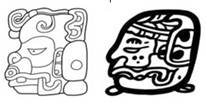




TOK.p34.r5.c4 BMM9.p18.r5.c4 BMM9.p20.r1.4 25EMC.pdfp32.#8.1&2&3 [JM.p69.#2 = 25EMC.pdfp32.#8.1]
CHUWEN CHUWEEN CHUWEEN CHUWEN

TOK.p14.r1.c3
se / cha / CHUWEN





K&L.p14.#7 TOK.p30.r3.c2 Schele Stuart = Safronov
LTI Kimbell Panel J3 LTI Panel 4 M1
CHUWEN? CHUWEN TI:CHUWEEN? TI’?:CHUWEEN? TI’:CHUWEEN?

![]()
MHD.AM5b.1&2 T755
CHUWEN? -

Houston-CC.p393.c2.fig13.2 (Houston)
God D Court Vessel
che.<he:na> ‘God D’ ti.<CHAN:TE’> CHUWEEN.na
· No glyphs given in K&H.
· Although TOK consistently writes long, aspirated, and glottalized vowels, it gives the pronunciation of this logogram as CHUWEN (short e).
· Variants (3-4):
o A. Abstract (“the eye of the monkey”) – features:
§ “Elbow-shaped” element (could be the eyebrow).
§ The “elbow” embraces se (which represents the eye itself).
o B. Reduced abstract – features:
§ The “elbow-shaped” element of the abstract variant is omitted.
§ This leaves just the se, which represents the eye itself.
o C. Representational – features:
§ Mammal head – in this case a monkey.
§ “Elaborate” ear – long, three sections, along (almost) the full length of the right of the head.
§ “Darkness” (AK’AB) infixed into ear. In fact, to be more precise, one can often see that the AK’AB is infixed in an obsidian blade, which is in turn infixed into the ear / right side of the head.
§ (Optional) mouth tendril going starting from the right of the mouth, doing down and yet further to the right.
o D. Representational – features:
§ Anthropomorphic head with a “skullcap”-like element on the top of the head. It appears to be an element consisting of “tiled” sub-elements, with these “tiles” being rounded (MHD.AM5b.2).
§ (Optional) “darkness” (AK’AB) infixed in an obsidian blade infixed in the top right.
§ Mouth tendril going starting from the right of the mouth, doing down and yet further to the right.
It’s not totally clear if this variant should be distinguished from the monkey head variant. While both variants can have a mouth tendril (and “darkness” infixed in an obsidian blade infixed in the right of the head), the monkey head variant appears not to have the “skullcap” element whereas the anthropomorphic head variant can have the “skullcap” element. Also, this variant – MHD.AM5b.2 (read as CHUWEN) – is difficult to distinguish from MHD.AM5c.2/0755st (read as ITZ’AT/ITZ’AAT). They both are anthropomorphic heads with a tiled skullcap. The main differences are:
§ CHUWEN has a closed mouth whereas ITZ’AT/ITZ’AAT has an open mouth.
§ CHUWEN can have a mouth tendril whereas ITZ’AT/ITZ’AAT doesn’t have one.
Note also that although CHUWEN and ITZ’AT/ITZ’AAT are in theory different words, in this particular context, they’re semantically very close, as they both refer to highly educated / literate and “wise” individuals.
· Very superficially, K’ABA’ can be mistaken for the abstract variant of CHUWEEN because they both have the “reflected-and-rotated-L” shape. However:
o K’ABA’ has crossed bands at the midpoint of the “L”, whereas CHUWEEN has “struts”.
o The ends of the “L” of K’ABA’ don’t “curl around” (and have a series of ticks), whereas the ends of the “L” of CHUWEEN “curl around” slightly (and have no ticks).
o The “L” of K’ABA’ embraces a K’UH or ch’ok, whereas the “L” of CHUWEEN embraces a se.
· Chuween is a “magical” monkey, as opposed to maax and baatz’, which are real ones. AT-E1168-lecture9.t0:05:23-05:50: In the same way, there is a word for monkey: maax, and it’s a spider monkey (“mico de noche”). There is a word baatz’, and it’s a howler monkey. But there is also a chuween monkey, which is a magical monkey, a special monkey – a kind of scribe who helps in the creation of humanity. And he is the patron of the day “Chuween”. [Sim: note that officially, “mico de noche” is Potus flavus, the kinkajou, though I suppose it could mean “spider monkey” in the regional forms of Spanish in the Maya-speaking areas of Mexico. In any case, chuween never means “kinkajou”, which is uy in Classic Maya.]
· It may occur in the context of the name of the carver of LTI Kimbell Panel and LTI Panel 4 – yuxul mayuy ti’ chuween = “the carving of Mayuy Ti’ Chuween” (“Mist Mouth Monkey”).
o See also ZenderEtAl-SSw (2016) where Mayuy Ti’ Chuween is mentioned several times.
o However, there is some doubt that the last part of the carver’s name is actually Chuween:
§ HoustonEtAl-AUiaML-II.p6 (2017): However, the mammalian head at the end of Mayuy’s name [LTI Kimbell Panel J3 and LTI Panel 4 M1] eludes decipherment. Marked with signs for “dark/night,” ak’ab, it may be a nocturnal animal with long ear (Stone and Zender 2011:144–145), but there are insufficient clues to clinch the identification. At an impasse, we simply call him “Mayuy,” drawing on the first elements of his name.
§ Houston-NGA2023-lecture2.t0:11:03-17:21 (2023) – where more than 5 minutes of the lecture are devoted solely to Mayuy and his four major monuments – also avoids any reading for this glyph, and also refers to the carver only as “Mayuy”.
§ MHD assigns the code AM5b, which is mapped to T755 in the MHD Concordance but registers some doubt in the reading by adding a question mark: CHUWEN?.
§ Indeed, both the Stuart and Safronov drawings do not allow an unambiguous reading of CHUWEEN (Safronov’s drawing even less than Stuart’s).
· Houston-CC.p393.c1.l-9: … cheheen “God D” ti-4-te’ Chuween, “so says God D to the 4 monkeys”, a set of beings tied to scribal craft.
· In Naranjo, a common title is Sak Chuween and it has a meaning related to “monkey”, see:
o Tokovinine&Fialko-St45oN: 10 occurrences of chuween.
o Tokovinine-SKC: 10 occurrences of chuween.
o Skidmore-ULoENR: 3 occurrences of chuween.